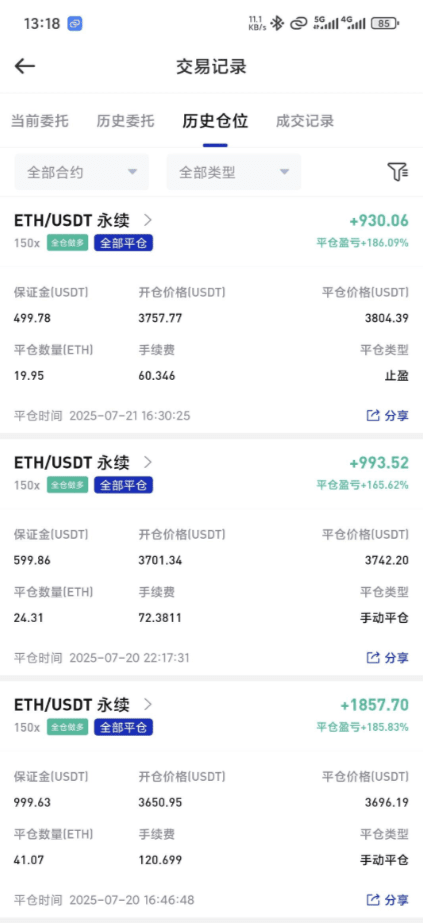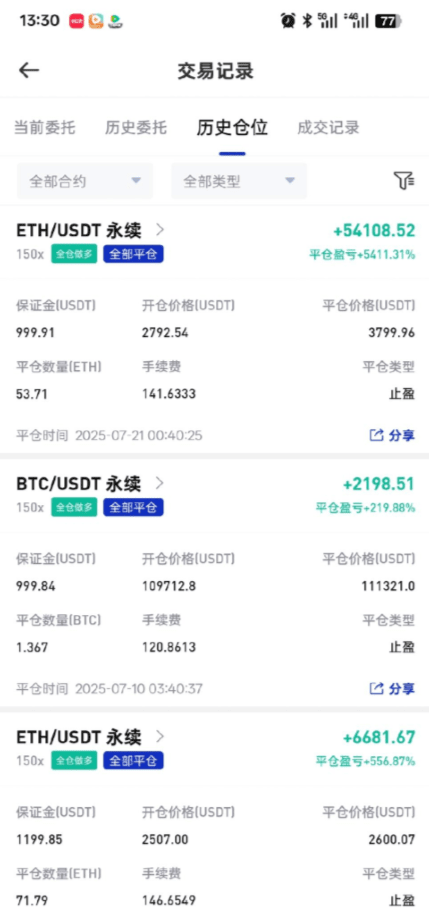I've seen people roll 5000 to 1 million in half a year, and I've also seen people earn 500,000 one day and lose everything the next — this isn't a matter of luck, but the stark difference in executing rolling strategies. After 4 years of contract trading, the pits I've stepped into could fill a truck, and the strategies I've summarized boil down to two words: 'Guard' and 'Be ruthless' — steady as a mountain when you need to guard, and never hesitate when it's time to be ruthless.
1. Wait: 90% of the time waiting, 10% of the time earning.
Newbies in contracts often feel that 'not trading is losing'; they feel uncomfortable if they don't open a position in a day. But the people I've seen making money are 'snipers' — they spend 90% of their time lying still, waiting for the best moment to pull the trigger.
Last year, a fan started with 5000 and traded daily for three months, spending over 800 on fees, ending up 30% down. Later, he learned from me to 'wait for the right market', only acting when BTC or ETH showed 'violent market' conditions: such as breaking key resistance levels or increasing by more than 5%. As a result, in the fourth month, he made 40% on one trade, equal to all the chaotic efforts of the previous three months.
What is a 'violent market'? There are three signals:
Breaking through key levels + increased volume: BTC has been consolidating around 30,000 for half a month, suddenly breaking through 32,000 with a large bullish candle, and the trading volume is three times that of the previous day — this indicates 'capital is seizing opportunities'; entering at this moment, there is a high probability of over 10% volatility within 3 days.
Trends driven by news: After major announcements like the Federal Reserve cutting interest rates or Bitcoin halving, the market often continues for a while. Last year, on the day the Fed announced the rate cut, I waited 2 hours to confirm the trend before entering the market, earning 30% in 5 days.
Sector-wide upward movement: for example, if the DeFi sector rises collectively, with leading tokens increasing by 10%, other tokens follow — this indicates 'it's not just a single token market, but a sector opportunity', providing higher safety.
Waiting in the market means 'resisting the urge to act'. I have a timer on my phone, forcing myself to 'open at most 2 positions' each day. Before entering, I must watch the K-line for 15 minutes; many impulsive trades are suppressed this way. Remember: in the contract market, missing 10 opportunities is not scary; what's scary is one impulsive move that wipes out your principal.
2. Rolling: Using profits to roll, the principal is always a 'safety cushion'.
'Adding positions after making profits' is a fatal flaw for contract newbies. I once earned 50% on ETH, got overly excited, and added all my principal and profits, only for the market to reverse, wiping out not only my profits but also leading to a 20% loss of my principal. It was only later that I understood: the principal is 'life', and profits are 'icing on the cake'; they should not be confused.

Now my trading rule is:
For the first profitable trade, withdraw the principal first: with a 5000 principal, if the first trade earns 1000 (20%), immediately withdraw the 5000 principal, and continue playing with just the 1000 profit. This way, even if you lose everything later, you only lose the money earned, with the principal intact.
Profit rolling, stepwise increasing positions: when profits reach 2000 (doubled), increase positions by at most 50% (1000); when profits reach 4000, increase another 50% (2000). Always leave a 'buffer zone' for profits, don't put all your eggs in one basket.
After doubling, leave a safety cushion: if profits double (for example, 1000 becomes 2000), immediately withdraw 30% (600) to a stablecoin wallet, leaving 1400 to continue rolling. This 600 is your 'safety cushion'; even if you lose later, you've solidly secured 600.
Last year, in one month, I rolled 10,000 in profits, doubled it twice along the way, and took out a 30% safety cushion. Even if the market corrected, I still netted 12,000 — many people fail to make money because they treat 'paper profits' as 'real earnings' and do not understand the importance of 'locking in profits.'
3. Adjust: The stop-loss line follows the profits, avoiding 'roller coaster' trading.
'After earning 50%, move the stop-loss line to the cost price' — this is a lesson I learned from a 30,000 loss.
When I first started trading contracts, I always set my stop-loss line firmly 3% below the entry price. As a result, once ETH retraced from a 50% profit to a 10% profit, I didn't act, thinking 'it can rise back', and ultimately it fell to the stop-loss line, resulting in a 3% loss.
Now I've learned 'dynamic stop-loss adjustment':
If floating profit is within 50%, set the stop-loss line 3% below the entry price (regular stop-loss).
If floating profit exceeds 50%, move the stop-loss line to the 'entry price' (cost price) to ensure 'no loss of principal'.
If floating profit exceeds 100%, move the stop-loss line up to 'entry price + 50%', locking in half of the profits.
Once, when SOL had a floating profit of 80%, I moved my stop-loss line up to the cost price. Later, it retraced to 2% above the cost price, I didn't stop-loss, and it eventually rose by 50% — I preserved my profit without missing the trend. The core of this tactic is 'let profits protect themselves'; if it rises, you earn more, if it falls, you don't lose, keeping a stable mindset.
4. Stop: Failing to hold onto profits is equivalent to earning nothing.
'Not taking profits after earning leads to the final emptying' — this is the harsh truth of the contract market. I've seen too many people hesitate to sell when their positions are up by 50% or 100%, only for the market to reverse and wipe out all profits, even resulting in losses.
My profit-taking principle is 'take profits in batches, and secure gains as they come':
Floating profit of 30%, take profits of 30%: for example, entering with 10,000 in profits, earning 3000, take 30% first (3000 in corresponding position), bringing back 900 in profits.
If floating profit is 50%, take 40% profit: The remaining 7000 position earned 3500, and then selling 40% brings back 1400.
Floating profit of 100%, clear positions or leave 10% to bet on the market: for the remaining 30% position, either sell everything or留10% to gamble higher, but never be greedy.
During last year's BTC market, I used this profit-taking method to clear my positions at a floating profit of 120%. Although it later rose by 50%, I had already secured a 120% profit — many people always aim to 'sell at the highest point', but end up missing even the 'relative high points'.
The core of taking profits is 'accepting imperfection'. There is no god in the crypto world who can 'sell at the highest point'; being able to lock in most profits during an upward trend already beats 90% of people.
Why can some people roll 5000 to 1 million, while others lose all after earning 500,000?
The former understands 'waiting': only act in certain market conditions, lurking like a hunter; if you don't act, you won't miss.
The former understands 'rolling': using profits to play, with the principal always safe, maintaining a calm mindset, operations won't become distorted.
The former understands 'adjusting': dynamically adjusting stop-losses, letting profits bear the risk themselves, earning more when it rises, and not losing when it falls.
The former understands 'taking profits': securing gains is more important than pursuing 'higher' profits.
The latter, however, often involves 'not waiting, rolling randomly, not adjusting, and not taking profits' — when the market comes, they rush in, increase principal when they earn, don't adjust stop-loss, and rely on fantasies for profit-taking, ending up losing everything.
Finally, a piece of advice for those looking to turn their fortunes by rolling:
The core of the rolling strategy is not 'earning quickly', but 'surviving longer'. Rolling 5000 to 1 million is not dependent on one windfall, but the accumulation of countless times 'waiting for the right market, using profits to roll, adjusting stop-losses well, and timely profit-taking'.
You don't need to become a 'contract master'; you just need to execute these details well: resist the urge when you should wait, use profits when you should roll, adjust stop-losses when you should, and don't be greedy when taking profits. If you can do this, even if you can't roll 200 times, at least you can survive longer in the crypto space, and living longer means you'll eventually encounter your own opportunity.
The cryptocurrency market changes rapidly, but those who can make money are always those who 'understand how to control themselves'. Don't let the market's fluctuations dictate your actions; from today, engrave every step of the rolling strategy into your mind, and when the next market arrives, you will thank your present self.



